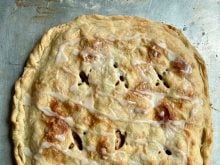March is national nutrition month and this year the campaign focuses on students making wise food choices at schools and in their communities.
Contents of the school vending machines and the availability of healthy choices for food eaten away from home are topics of interest. The size of food portions, the amount of salt in packaged food and the placement and pricing of nutritious food all affect the health of our children.
In the Canadian Community Health Survey in 2004, 26 percent of children between ages two and 17 years were overweight and eight percent were obese. Between 1978 and 2004, the rate of overweight teenagers doubled from 14 to 29 percent and obesity rates tripled from three to nine percent.
Read Also

From farmer to award-winning distiller
Pivot Spirits showcases transition from farmer to distiller with provincial award-winning results in Alberta for Lars Hirch
These teens are at risk for high blood pressure, high cholesterol, diabetes, asthma, orthopedic injuries and sleep apnea. Heavier teens tended to eat less than five daily servings of fruits and vegetables, skipped breakfast, were less active and ate out instead of at home.
At home, eating healthy foods, being physically active and valuing family dinners can help teens develop habits to become healthy adults.
Schools can also be part of the solution in improving nutrition. Children eat a third of their food during the school day, about one-sixth of their entire annual nutrition intake. Healthy children learn better as shown in the following study.
In Saskatchewan, several stakeholders have provided funding and support for a breakfast and snack program in elementary schools. A recent study of 17 schools showed the perceived benefits were nutritional, educational, economic and social.
Nutritional benefits included increased food security, access to healthy food choices, new food experiences and improved knowledge of nutrition. Educational benefits included classroom management and improved learning capacity and well being. Economic benefits included support for local agriculture and grocers, employment for the nutrition co-ordinators and added support for families when food budgets are depleted.
Common sense tells us that we can learn and think more clearly when we are adequately fed. The study found that the nutrition programs ensure that every child comes to school ready to learn. This study recommended that government agencies, school and community partners continue to strengthen the community-based approach to nutrition programs in schools.
To learn more, visit the website www.breakfastforlearning.ca.
Across the country
At a national level, the Canadian Home Economics Foundation gives grants that support home economics and family studies projects or programs in Canadian schools that will benefit low-income or at-risk students.
As well, most provinces are supporting the improvement of the nutritional health of students. For example:
- British Columbia recently released Guidelines for Food Sales in B.C. Schools promoting healthy food choices. See www.bced.gov.bc.ca/health/health_publications.htm.
- In Alberta, a School Nutrition Handbook – Feeding the Future provides practical advice for those interested in school nutrition. See www.calgaryhealthregion.ca/hecomm/nal/ProgramsServices/SchoolNutritionProgram/SchoolNut.htm.
- The Saskatchewan School Boards Association working with public health nutritionists has released Nutrition Guidelines for Schools. It is available on-line at www.saskschoolboards.ca, under education services, research and development, students-diverse needs, Research Centre Report #04-01.
- The Manitoba Healthy Kids, Healthy Futures Task Force released recommendations that require all schools to have written school food and nutrition polices as part of their school plan.
- Ontario recently released guidelines to assist student nutrition programs to select good food. See www.children.gov.on.ca/NR/CS/BestStart/En-NutritionGuidelines.doc.
- Nova Scotia and New Brunswick have also adopted school food and nutrition policies, and Prince Edward Island has developed a Healthy Eating Toolkit.
Around the world
The International Federation of Home Economics uses education to teach families how to use their resources in an effective way and improve their quality of life. For more information, contact www.ifhe.org.
Healthy food for students
Here are some ideas to follow Canada’s Food Guide daily recommendations.
To eat five to 12 grain products:
- Whole-wheat crackers, bread or buns.
- Whole wheat bagel with cream cheese or peanut butter.
- Whole wheat pitas filled with vegetables, beans, turkey, cheese or fruit.
- Pasta or rice dish in a small container.
- Cold pizza.
- Granola or meusli.
To eat five to 10 fruits and vegetables:
- Carrot and celery sticks, red or green pepper, mushrooms, zucchini or cucumber slices.
- Apple, orange, banana, cantaloupe or melon slices, peach, pear.
- Fruit and peanut butter rolled in a tortilla.
- Green salad made with the child’s choice of ingredients.
- Fruit salad.
Try different combinations: Some kids like celery and peanut butter. Apples sprinkled with cinnamon taste good.
If your child participates in the lunch planning, they may try new ideas. Even apple pie, pumpkin pie, or fruit crisps are better to eat for breakfast rather than skipping the most important meal of the day.
To consume three to four milk products:
- Yogurt plain or sweetened with honey, maple syrup or fruit.
- Yogurt with granola, dried cereal and fruit.
- Cheeses of different kinds.
- Cheese and fruit kabobs.
- Milk and fruit smoothies sent in a Thermos.
- Chocolate milk.
To eat two or three meats and alternatives:
- Nuts (peanuts, almonds, cashews, pecans).
- Seeds (sunflower, pumpkin).
- Baked beans (in a Thermos).
- Boiled eggs or egg salad on bread.
- Quesadillas (melted cheese and veggies on whole-wheat tortilla).
- Homemade soups, stews or chili.
- Bean rollups or tacos.
Bean roll-ups
1 small or large tortilla,
white, wheat or flavoured
1/2 cup or more refried beans 60 mL
2 tablespoons salsa 30 mL or sliced tomato
2 tablespoons grated cheese, 30 mL
optional
Spread beans on the tortilla. Top with salsa or tomato and cheese, if using. Roll tightly. Slice, if desired.
Barbara Sanderson is a home economist from Rosetown, Sask., and one of four columnists comprising Team Resources. Send correspondence in care of this newspaper, Box 2500, Saskatoon, Sask., S7K 2C4 or contact them at team@producer.com.














